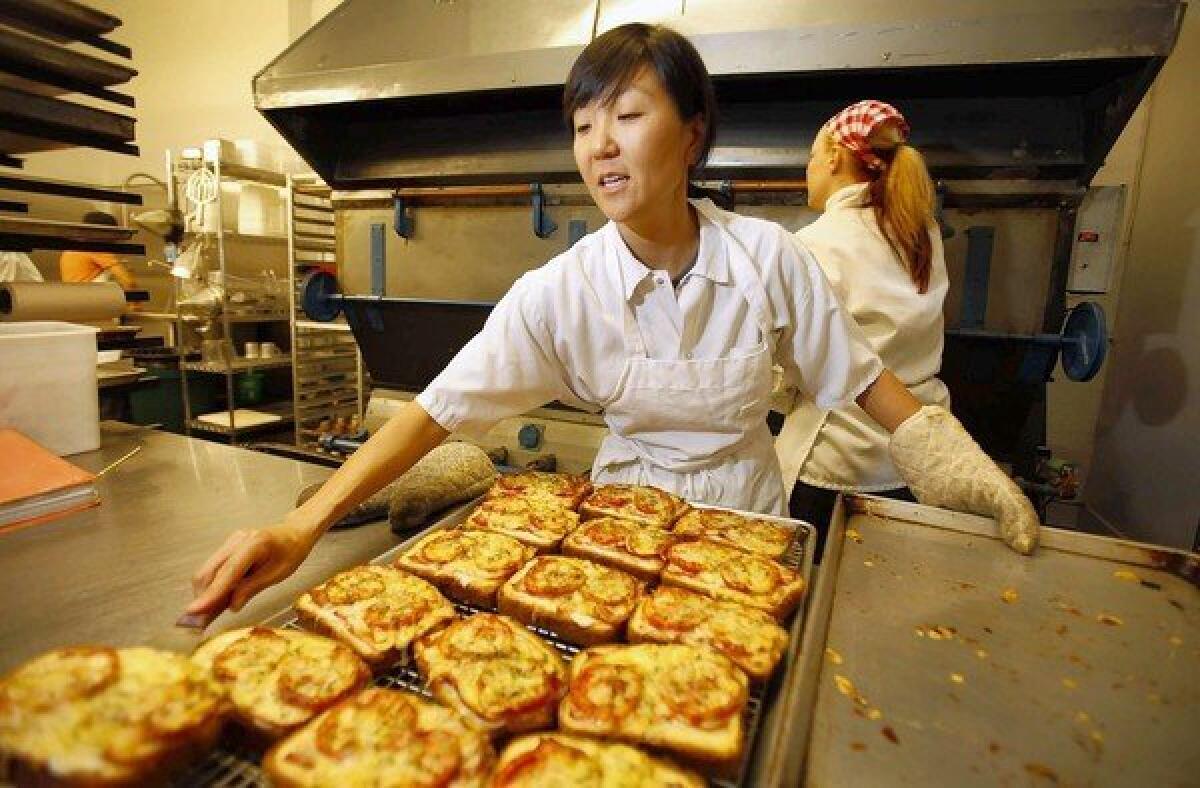A quirky bakery where stellar croissants come from

- Share via
If the heart of a bakery is its oven, then Proof Bakery’s is ginormous. Really. It’s a gas-powered Dalton with double doors and revolving shelves that can fit 18 sheet trays — or 72 pies — at a time. The oven, about the size of a 10-foot U-Haul truck, is 50 years old, inherited with the space, and its quirks provide the cult Atwater bakery its pulse.
“When someone first showed me how to light it, you had to fill a basin with gas, light a newspaper and throw it in,” says owner Na Young Ma. “It was like ‘Backdraft.’
“But I have learned to love it.” (She also has since installed a modern igniter.)
Proof Bakery in Atwater Village has become a neighborhood hit since opening in November 2010. But it is still a tiny operation awkwardly outfitted with large-scale kitchen equipment, much of it from the original bakery, the Rollin’ Pin Bake Shop (which opened in 1962).
There’s no air conditioning in the production area of the bakery, and there’s no stovetop, so custards and pastry creams are made on a single gas burner in the corner. Like the oven, the dough sheeter is decades old, and so are the two commercial Hobart mixers that alternate breaking down every three months. Despite the challenges, Ma is developing a reputation as one of the area’s best bakers. In a recent blind tasting of croissants in the L.A. Times Test Kitchen, Proof’s finished third, ahead of some much bigger names.
And now Ma is preparing to take the next steps to expand production. Thankfully. Because inevitably at Proof somebody in front of you in line will buy the last peanut butter cookie with apricot jam, loaf of brioche, fig tart with diplomat cream or flourless chocolate cake. With fall approaching, recently spotted in the bakery case: fig oat cake and French apple tarts. “Maybe even apple strudel,” says Ma, who is 37 years old and not even as tall as one of her mixers
“We can only produce so much,” says Ma, who fell for bread during an after-college job as a night baker at Amy’s Bread in New York’s Chelsea Market. She’d take the crosstown bus from her apartment in the East Village, get to work at 10 p.m. to bake loaves of baguettes and organic miche and finish her shift at 6 in the morning. After several months, she says, her mom started to wonder what she was going to do with her art history degree from Cornell.
Eventually Ma, who is from Glendale, moved back to California to enroll in the Culinary Institute of America’s pastry program. “I knew I didn’t want to be a pastry chef making plated desserts on the line,” she says. “The goal always was to have my own place.”
Maybe it’s the fact that Ma is a bread baker at heart and adds a little sourdough starter to her croissants that makes them so good. On a recent sweltering afternoon, she and three bakery assistants are shaping croissants on day two of a three-day process to make the flaky pastries (the first day the dough is mixed and proofed, the second day it goes through several laminations before shaping, and on the third day they’re baked).
“Time is of the essence. It’s high stakes,” says bakery manager Jules Exum, because there’s no air conditioning, and if the butter melts in the dough, the delicate layers are ruined. Sheets of ice packs are splayed onto the wooden pastry table to cool it down. “Sometimes Enrique [Choto] shapes the ham-and-cheese croissants inside the walk-in freezer.”
The eight sheet trays of croissants will be baked at 400 degrees the next morning on the left side of the oven, which gets hotter than the right. Brioche loaves or frangipane tarts get baked at the same temperature setting and could go in at the same time on the right side, but not biscuits or gougeres (those need to be baked on the left). Bricks in the corners of some of the oven shelves help to level their off-kilterness.
“I’m starting to discover the oven’s strengths,” says Ma. Keeping up with its idiosyncracies “has made us better bakers.”
3156 Glendale Blvd., Los Angeles, (323) 664-8633, www.proofbakeryla.com. Open Tuesday to Sunday 8 a.m. to 4 p.m.
More to Read
Eat your way across L.A.
Get our weekly Tasting Notes newsletter for reviews, news and more.
You may occasionally receive promotional content from the Los Angeles Times.











